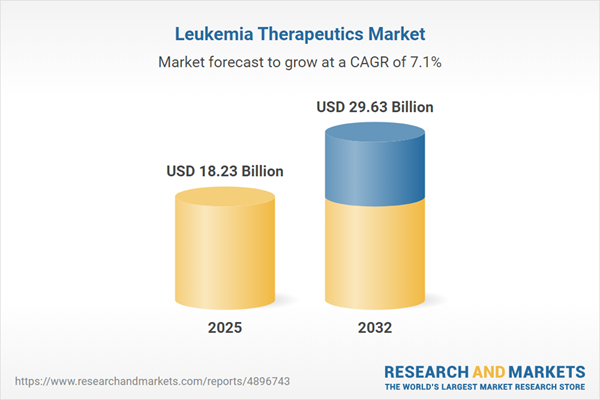Speak directly to the analyst to clarify any post sales queries you may have.
The leukemia therapeutics market is undergoing transformative change, driven by rapid advancements in science, evolving regulatory policies, and renewed collaboration between healthcare stakeholders. Decision-makers seeking actionable market intelligence will find this report essential for navigating emerging trends and competitive strategies.
Leukemia Therapeutics Market Snapshot
The Leukemia Therapeutics Market grew from USD 17.07 billion in 2024 to USD 18.23 billion in 2025. It is expected to continue growing at a CAGR of 7.13%, reaching USD 29.63 billion by 2032. This trajectory is supported by dynamic R&D activities and swift commercialization of innovative therapies. Growth is further fueled by precision medicine and immuno-oncology breakthroughs, sustained healthcare investment, and global initiatives to improve disease management and patient access.
Scope & Segmentation of the Leukemia Therapeutics Market
- Leukemia Types: Acute lymphoblastic leukemia, acute myeloid leukemia, chronic lymphocytic leukemia, chronic myeloid leukemia, hairy cell leukemia, juvenile myelomonocytic leukemia, T-cell prolymphocytic leukemia
- Mechanisms of Action: Immunotherapy including bispecific T-cell engagers, CAR-T cell therapy, immune checkpoint inhibitors, monoclonal antibodies; targeted therapies such as BCL-2, CDK, FLT3, IDH1/IDH2, PI3K, and tyrosine kinase inhibitors
- Line of Therapy: First-line therapy, second-line and salvage therapy
- Route of Administration: Intrathecal, intravenous, oral, subcutaneous
- Age Groups: Adult, geriatric, pediatric populations
- End-Users: Academic research institutes, cancer treatment centers, hospitals, specialty clinics
- Regions Covered: Americas (including United States, Canada, Mexico, Brazil, Argentina, and others), Europe, Middle East & Africa (including UK, Germany, France, Saudi Arabia, South Africa, and more), Asia-Pacific (including China, India, Japan, Australia, and others)
- Key Market Players: Major pharmaceutical and biotech companies, global and regional innovators, academic collaborators, contract manufacturing organizations
Key Takeaways for Decision-Makers
- Precision approaches continue to replace traditional treatments, targeting specific genetic and immunological factors to personalize care for leukemia patients.
- Immunotherapy advancements and emerging cell-based modalities are influencing remission outcomes and driving significant pipeline differentiation among industry leaders.
- Collaborative models between industry and academia are driving innovation, fostering faster translation of foundational research into viable therapeutic options.
- Adoption of digital health tools and real-world evidence platforms is accelerating evidence generation, supporting regulatory decisions and payer negotiations for label expansion.
- Disease subtype and patient age-specific strategies are influencing treatment sequencing, regimen selection, and patient adherence, particularly as oral therapies and targeted small molecules gain traction.
- Regional dynamics, including streamlined regulatory pathways and expansion of domestic manufacturing, are shaping access and market entry strategies across key global markets.
Tariff Impact and Supply Chain Considerations
The introduction of new United States tariff measures on imported pharmaceutical materials has added complexity to cost structures and sourcing decisions. Industry stakeholders are mitigating these effects through nearshoring, dual sourcing, and strategic inventory management. Regulatory authorities are responding with expedited review processes and potential waivers, maintaining supply continuity and minimizing patient impact. Ongoing monitoring of tariff shifts remains critical for sustaining therapeutic innovation and patient access.
Methodology & Data Sources
This report employs a rigorous multi-source approach, integrating secondary research from peer-reviewed studies, clinical trials, and regulatory filings with primary expertise from oncologists, pharmacoeconomists, and supply chain professionals. Data triangulation ensures consistency across all findings, while qualitative assessments and pipeline mapping provide detailed insight into therapeutic, clinical, and regional trends.
Why This Report Matters
- Enables senior leaders to benchmark against evolving clinical and regulatory standards, supporting informed investment and partnership decisions.
- Highlights actionable strategies for entering high-growth segments, optimizing product portfolios, and sustaining revenue in diverse market environments.
- Provides granular intelligence on patient segments, mechanisms of action, and geographic opportunities essential for strategic planning and innovation.
Conclusion
The leukemia therapeutics market is reshaping global patient outcomes and industry priorities through scientific innovation, regulatory engagement, and strategic collaboration. Market participants prepared to adapt to shifting policies and invest in patient-centric solutions will capture long-term value in this evolving landscape.
Additional Product Information:
- Purchase of this report includes 1 year online access with quarterly updates.
- This report can be updated on request. Please contact our Customer Experience team using the Ask a Question widget on our website.
Table of Contents
3. Executive Summary
4. Market Overview
7. Cumulative Impact of Artificial Intelligence 2025
Companies Mentioned
The companies profiled in this Leukemia Therapeutics market report include:- AbbVie Inc.
- Amgen Inc.
- AstraZeneca PLC
- Biogen Inc.
- Celgene Corporation by Bristol Myers Squibb Company
- Eisai Co., Ltd.
- Eli Lilly and Company
- EUSA Pharma (UK) Limited
- F. Hoffmann-La Roche Ltd.
- Gilead Sciences, Inc.
- GlaxoSmithKline PLC
- Incyte Corporation
- Johnson & Johnson Services, Inc.
- Novartis AG
- Pfizer Inc.
- Servier Pharmaceuticals LLC
- Takeda Pharmaceutical Company Limited
- Teva Pharmaceutical Industries Ltd.
Table Information
| Report Attribute | Details |
|---|---|
| No. of Pages | 181 |
| Published | November 2025 |
| Forecast Period | 2025 - 2032 |
| Estimated Market Value ( USD | $ 18.23 Billion |
| Forecasted Market Value ( USD | $ 29.63 Billion |
| Compound Annual Growth Rate | 7.1% |
| Regions Covered | Global |
| No. of Companies Mentioned | 19 |









